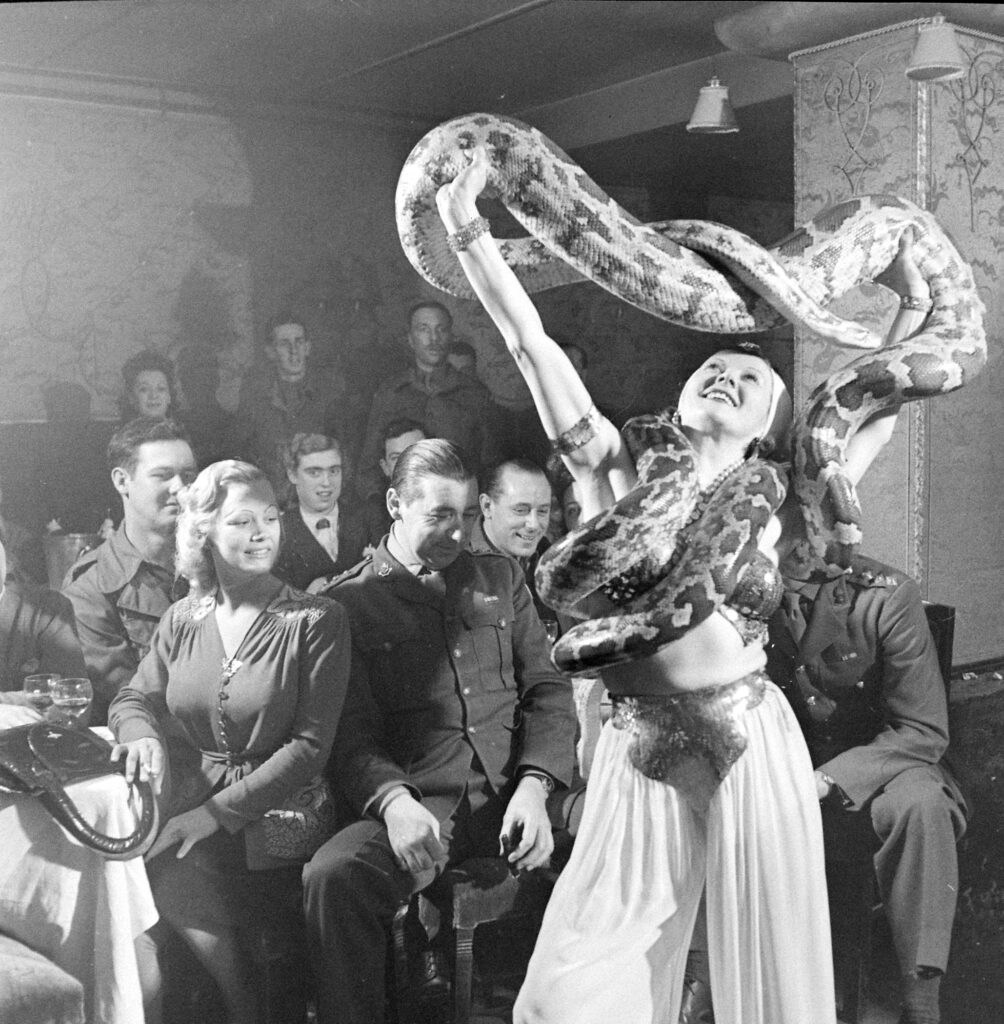In 1941 legendary LIFE photographer Alfred Eisenstaedt went to Atlantic City and chronicled the bustling activity and amusements of the beach town at its peak.
In these pictures you’ll see the 1940 Miss America, Frances Burke, who had been crowned the year before at Atlantic City’s Convention Hall, posing with her sash on the beach. You’ll see the crowds at night flocking to the legendary Steel Pier amusement park, while others enjoy fine dining in a grand hotel. You’ll see women wearing bathing caps into the ocean to protect their hairdos, as was common in those days. And you’ll see boardwalk attractions that were very much of their time: one booth charged people 15 cents (about $3 today) to have their blood pressure taken. The Sodamat” sold drinks for a nickel. People mobbed a Heinz 57 specialty store that was apparently trying to live up to its “57 varieties” slogan.
Also notable is the sheer prevalence of senior citizens, many of whom went out in the summertime sun wearing suits and dresses, as if they were going to a formal event rather than a day at the shore.
These photos were shot toward the end of the Atlantic City heyday that began in the early 20th century and waned as tourists moved on to other destinations. By 1977 the town’s fortunes had sagged enough that Atlantic City turned to legalized gambling, becoming the first U.S location outside Nevada to do so. The casinos that sprouted up along the boardwalk, some of them taking the place of the grand hotels of yesteryear, did provide a shot in the arm, but the benefits have proved fleeting, especially after competing casinos began popping up all around the country. In 2023 Atlantic City still claims 27 million visitors a year.
Its battle to recapture its glory days make Atlantic City something of an avatar for nostalgia itself. In 1980 Louis Malle directed a movie called Atlantic City in which a small-time mobster played by Burt Lancaster was so consumed by romantic visions of days gone by that he memorably declared to a younger character, “You should have seen the Atlantic Ocean in those days.”
In these photos you can do just that.

Aerial view of people at the beach, Atlantic City, N.J., 1941.
Alfred Eisenstaedt/Life Picture Collection/Shutterstock

Atlantic City, N.J., 1941.
Alfred Eisenstaedt/Life Picture Collection/Shutterstock

Frances Burke, winner of the 1940 Miss American pageant, joined Miss Atlantic City on the beach Atlantic City, N.J., 1941.
Alfred Eisenstaedt/Life Picture Collection/Shutterstock

People going onto the beach at Atlantic City, N.J., 1941.
Alfred Eisenstaedt/Life Picture Collection/Shutterstock

The beach at Atlantic City, N.J., 1941.
Alfred Eisenstaedt/Life Picture Collection/Shutterstock

Readers on a hotel terrace, Atlantic City, N.J., 1941.
Alfred Eisenstaedt/Life Picture Collection/Shutterstock

Atlantic City, N.J., 1941.
Alfred Eisenstaedt/Life Picture Collection/Shutterstock

Boardwalk at Atlantic City, N.J., 1941.
Alfred Eisenstaedt/Life Picture Collection/Shutterstock

Atlantic City, N,J., 1941.
Alfred Eisenstaedt/Life Picture Collection/Shutterstock

Atlantic City, N.J., 1941.
Alfred Eisenstaedt/Life Picture Collection/Shutterstock

Lifeguards in action, Atlantic City, N.J., 1941.
Alfred Eisenstaedt/Life Picture Collection/Shutterstock

Sketch artists on the beach, Atlantic City, N.J., 1941.
Alfred Eisenstaedt/Life Picture Collection/Shutterstock

The boardwalk at Atlantic City, N.J., 1941.
Alfred Eisenstaedt/Life Picture Collection/Shutterstock

Posted regulations, Atlantic City, N.J., 1941.
Alfred Eisenstaedt/Life Picture Collection/Shutterstock

A wicker rolling chair passed by a Philip Morris tobacco shop, Atlantic City, N.J. , 1941.
Alfred Eisenstaedt/Life Picture Collection/Shutterstock

Crocheting on the boardwalk, Atlantic City, N.J, 1941.
Alfred Eisenstaedt/Life Picture Collection/Shutterstock

The boardwalk at Atlantic City, N.J., 1941.
Alfred Eisenstaedt/Life Picture Collection/Shutterstock

The boardwalk at Atlantic City, N.J., 1941.
Alfred Eisenstaedt/Life Picture Collection/Shutterstock

People crowded a hot dog stand on the boardwalk at Atlantic City, N.J., 1941.
Alfred Eisenstaedt/Life Picture Collection/Shutterstock

The boardwalk at Atlantic City, N.J., 1941.
Alfred Eisenstaedt/Life Picture Collection/Shutterstock

Boardwalk at Atlantic City, N.J,, 1941.
Alfred Eisenstaedt/Life Picture Collection/Shutterstock

Atlantic City, N.J., 1941.
Alfred Eisenstaedt/Life Picture Collection/Shutterstock

An exterior view of the Brighton Hotel in Atlantic City, N.J. in 1941.
Alfred Eisenstaedt/Life Picture Collection/Shutterstock

Frances Green (right) of Baltimore and Charles McIntosh of Brampton, Ontatio enjoying a ride in a wicker rolling chair through the pergola at the Brighton Hotel en route to the beach, Atlantic City, N.J., 1941
Alfred Eisenstaedt/Life Picture Collection/Shutterstock

Atlantic City, N.J., 1941.
Alfred Eisenstaedt/Life Picture Collection/Shutterstock

Nurses tending to afflicted children as they lie on a sun deck, Atlantic City, N.J., 1941.
Alfred Eisenstaedt/Life Picture Collection/Shutterstock

The Knife & Fork restaurant, Atlantic City, N.J, 1941.
Alfred Eisenstaedt/Life Picture Collection/Shutterstock

Lucy the Elephant in Margate, N.J., not far from Atlantic City, N.J, 1941.
Alfred Eisenstaedt/Life Picture Collection/Shutterstock

Ice skating, Atlantic City, N.J., 1941.
Alfred Eisenstaedt/Life Picture Collection/Shutterstock

People dining at the Marlborough-Blenheim Hotel in Atlantic City, N.J., 1941.
Alfred Eisenstaedt/Life Picture Collection/Shutterstock

Ice capades at the Convention Hall in Atlantic City, N.J., 1941.
Alfred Eisenstaedt/Life Picture Collection/Shutterstock

Atlantic City, New Jersey, 1941.
Alfred Eisenstaedt/Life Picture Collection/Shutterstock

People gathering outside of Steel Pier in Atlantic City, N.J., 1941.
Alfred Eisenstaedt/Life Picture Collection/Shutterstock














































































































